Very few cat breeds can be as energetic, athletic, and intelligent as the Abyssinian. The Aby, as fanciers call the breed, is a pure feline bundle of joy. It loves the attention it gets from its favorite human. It is an acrobat and an explorer at the same time. Abyssinians are super-smart with a hint of silliness. And with their unique ticked coat pattern, there is nothing you will not love about the Aby.
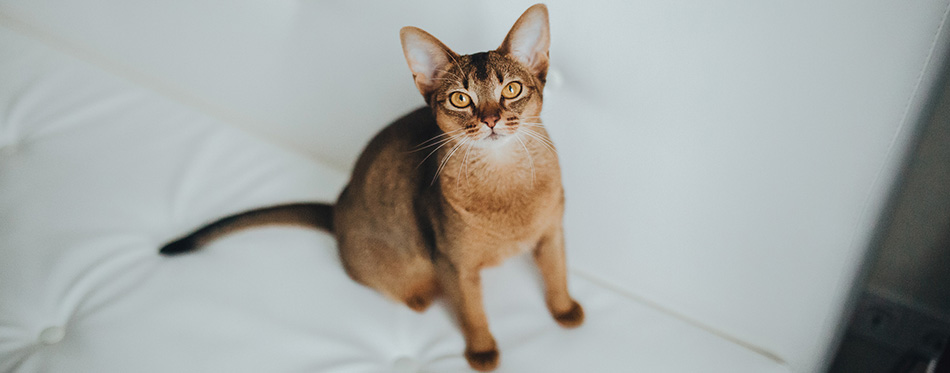
History of the Abyssinian Cat
There is reason to believe that the Abyssinian may have originated from modern-day Ethiopia. It is said that the modern Aby owes its existence to Zula, the first Aby in the western world. Zula arrived in Britain in 1868 when a British soldier brought the cat back home. There’s one issue, though. The Abyssinian War occurred from 1895 to 1896, about 27 years after the supposed entry of Zula into Europe.
There are also stories about the Abyssinian having descended from Egyptian cats. This is because of the cat’s almond-shaped eyes, big ears, and long necks. If these are accurate, then the Abyssinian is one of the world’s oldest feline breeds.
Genetic studies in the 21st century put the origins of the Aby far from the shores of Africa, however. There is now growing evidence that the actual origin of the breed is somewhere along the coast of the Indian Ocean as well as on several Southeast Asian countries. Documents in The Netherland’s Leiden Zoological Museum reveal that the Aby is a descendant of an Indian cat. The earliest reference was between the years 1834 and 1836.
Being an overseas colony of the British Empire, it was common for British sailors to bring home with them some objects from India. As such, it is possible that the first Abyssinian to reach Europe came from India, not Abyssinia or modern-day Ethiopia. It is in Britain where the breed was further refined to what it is today.
World War II almost brought the Abyssinian to extinction. The never-ending bombing raids of the German Luftwaffe on British soil meant many cats were killed. Those that survived the bombings did not fare well, either, because of limited resources. After the war, there were only 12 Abyssinians left in England.
Across the Atlantic, the very first Abyssinians reached American soil in 1900. Abyssinian breeding programs did not begin until the 1930s, however. Because the US mainland did not suffer the same air raids that blanketed WWII England, there were still many Abyssinians left to restart the breeding program in the UK.
Today, the feline breed enjoys the recognition from the Cat Fanciers’ Association, The International Cat Association, the Federation Internationale Feline, the Australian Cat Federation, and the Canadian Cat Association, as well as other reputable cat registries around the world.
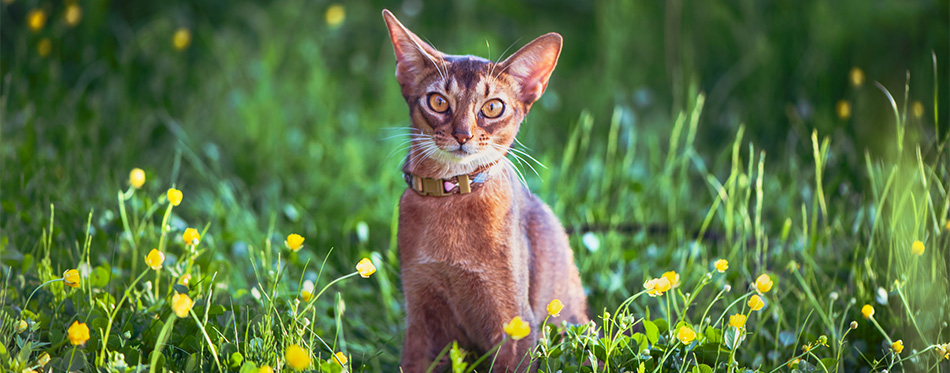
Quick Facts About the Abyssinian Cat
Cat fanciers say the Abyssinian is the feline world’s “runway model”. It is a beautiful and elegant member of the cat world. Here are a few more facts about the Abyssinian cat.
- Medium-sized cat
The Aby is a medium-sized feline that can weigh as much as 16 pounds. On the average, however, males tend to weigh 10 lbs, while female Abyssinians tip the scale at 8 lbs. It has a slightly-rounded, wedge-shaped head with matching almond-shaped eyes. The eyes are large, expressive, and brilliant. The body of the Abyssinian is moderate in length but is always graceful and lithe.
- A unique coat pattern
One of the distinguishing characteristics of the Abyssinian is its ticked coat pattern. This is something that it shares with the Somali and the Singapura, as well as other Asian cats. It is a tabby variant due to a gene that masks other tabby coat patterns. Each of the Aby’s fur comes with alternating bands of dark and light shades. It is often darker at the tips of the hair and lighter near the roots. This gives the cat its distinct “ticked” pattern.
- The different colors of an abyssinian
When you combine the ticked coat pattern of the Abyssinian with different coat colors, you’ll get an exotic-looking feline. While the cat can come in different colors, the Cat Fanciers’ Association only recognizes red, ruddy, fawn, and blue. The Federation Internationale Feline, on the other hand, recognizes ruddy, fawn, sorrel, and blue. Other cat fancier associations recognize chocolate, cinnamon, and lilac, in addition to the colors that the FIFe and CFA recognize.
It is also possible to have a silver-colored Abyssinian. This occurs if the white coloration near the hair root starts coming through the cat’s fur color. As such, you can have a silver-blue or a silver-red or any other silver variation of the Aby’s base coat color.
- A very active, acrobatic cat
The intense curiosity of the Abyssinian cat drives its activities. This is a breed that loves to play, run, jump, and do many things that other felines will not. It will bat an imaginary butterfly. Abyssinians can perform stunts and play with toys at amazing speeds. It is the feline equivalent of an Olympic sprinter. Their lithe and athletic bodies allow them to engage in activities that will easily tire many other cats.
Abyssinians are phenomenal jumpers. Many of them can leap 6 feet. This is an impressive feat. They also have a special fondness for heights. They will jump from one elevated platform to another, relying on their leaping abilities. It is wise to get a very tall cat tree with multiple elevated platforms if ever you have an Aby in the house.
Take a look at our review of Cat Hammocks for more options.
- The aby is an intelligent cat
Abyssinian Breeders International Kitten Buyer’s Guide author, Carolyn Osier, described the breed as the “most intelligent animal” on the planet. While no one can measure the IQ of cats based on human standards of intelligence, there are several breed traits that suggest the Abyssinian is an intelligent cat. These are cats that are very driven. They can be single-minded, very focused on the task at hand. They are relentless; always in search of something to do.
One good thing about this trait is that the Aby is quite easy to train. They are easy to potty-train and walk on a lead. One can teach an Aby to jump through a series of hoops or perform other cat tricks.
- Animal kingdom’s clowns
There is one characteristic of the Abyssinian that is quite unusual. Many people think of the breed as the animal planet’s natural clowns. They can outclass the Poodle when it comes to their funny antics. Their clownish behavior is due in part to their attention-seeking, active, and outgoing nature. They will perform a lot of crazy stunts that you will never see any other animal perform. They do this to get your attention. With its crazy antics, it is not uncommon for its pet owners to laugh out loud. In a way, the Abyssinian can be a great therapy cat to brighten your day.
- A curious kitty
By nature, cats are curious animals. They like to observe their surroundings. The Abyssinian takes the skill of an observer to greater heights, quite literally. This breed loves to spend countless hours perched by the window, observing people, plants, animals, and other objects pass by. Getting a bird feeder mounted on the outer surface of your window will give the Aby more entertainment than people can ever imagine. They have this intense curiosity about everything in the world that can make them stay fixated for hours. For a wider selection of choices, check out our cat window perches guide.
- Not a lap cat
If you’re looking for a cat that will cherish the time spent on your lap, the Aby isn’t for you. This is not at all surprising, given the cat’s remarkable energy levels. The only time it will seek out its human companion is when the Aby needs respite from a whole day of exploring, playing, and climbing. When it does find its owner, the Aby will not get on his lap. Instead, it will jump on its owner’s shoulder for a more unique vantage point of its surroundings.
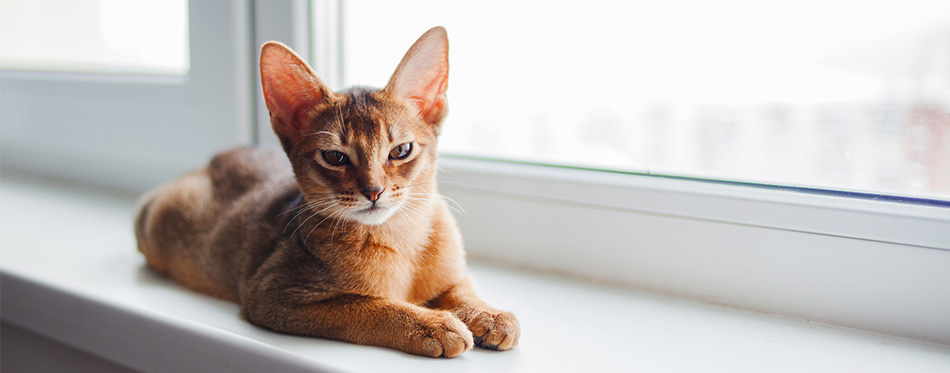
Things You Should Know
It is difficult not to fall in love with an Abyssinian cat. Its unique coat, innate intelligence, funny antics, and people-pleasing skills are all things we’d want from a pet cat. Before you bring an Abyssinian home, however, make sure you have a clear comprehension of the following.
Health
Abyssinians can live up to 12 years. If you observe the correct care for this feline breed, you can see it reaching 15 years of age. It does not mean the cat is already free from diseases.
One of the most common health problems of the Abyssinian cat is gingivitis. Inflammation of the gums can lead to other health issues like tooth loss and periodontal abscesses. Microorganisms can enter the bloodstream and cause infection elsewhere.
Abyssinians are also susceptible to some forms of neurological problems like hyperesthesia syndrome. One of the manifestations of the syndrome is excessive grooming. In some cats, they will also bite or chew on their fur and skin. This can lead to patchy hair loss. Some Abyssinians may be averse to being petted or touched because of this hypersensitivity.
Some Abyssinians can also have hereditary disorders like familial renal amyloidosis, pyruvate kinase deficiency, and hereditary retinal degeneration. Renal amyloidosis is a kidney problem that is due to AA amyloid protein gene mutation. Retinal degeneration in Abyssinians is the direct result of rdAc gene mutation. In pyruvate kinase deficiency, the cat lacks the enzyme that’s critical for metabolism in the Abyssinian’s red blood cells. This can result in anemia.
Many of these health conditions now have screening tests to help determine their presence in the cat. Having the Abyssinian undergo health screening tests can help prepare cat owners for the appropriate management of the condition.
Feeding
Abyssinians can benefit from a high-protein, high-calorie diet owing to their high energy nature. Dry cat food may be best for this breed because of its tendency to develop gingivitis. The rough texture of kibbles can help remove food particles and other debris on the cat’s teeth. This can help prevent the formation of plaque.
However, one has to be very choosy when it comes to dry cat food. There are many kibbles on the market that contain too many fillers of very little nutritional value. One always has to check the label to make sure that there are more recognizable animal-based proteins in the ingredient list than other ingredients.
If you are not sure about the best food for your Abyssinian, you can always ask your veterinarian. He can refer you to a veterinary nutritionist or help you determine the most appropriate diet for your cat.
For more guides on choosing the right cat food, you may wish to check out our reviews of the best wet cat food, senior cat food, hypoallergenic cat food, cat food for hairballs and best cat treats.
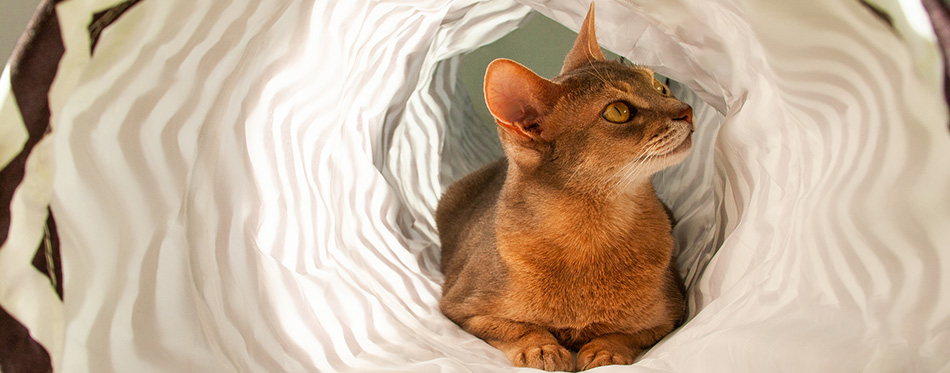
Care
Abyssinians should always be an indoor-only pet cat. This is a very friendly breed that loves watching and interacting with people. It is not unusual for it to approach a stranger, especially if that stranger entices it with something very interesting.
These cats can cost you up to $2,000 and more for purebred kittens. The lowest price you can get a purebred kitten for is around $700. Given its price tag, no pet owner should ever run the risk of losing an Abyssinian outdoors. From catnappers to toxic chemicals and hazardous activities, the outdoors is never a safe place for the Abyssinian cat.
Because there are several hereditary concerns with the Aby, it is best to schedule frequent veterinary visits. Screening tests are available to help determine the presence of risk factors in the animal. This lays the groundwork on what the pet parent needs to do next.
Veterinary dental cleaning and examination is also critical, since the breed is prone to gingivitis. All pet parents of Abyssinians should observe due diligence in brushing the cat’s teeth. This is not enough, however. That is why regular trips to the pet dentist is crucial. Dental scaling can help remove the buildup of plaque below the gum line. In some cases, root planing may be necessary to improve the cat’s protection against gingivitis.
Cleaning the Aby’s litter box is crucial. It prevents the proliferation of germs that can make the cat sick. Removing soiled litter is a must every day. Performing a deeper cleaning every week is also a must. For more options, check out our detailed review of cat litter.
The secret to the Abyssinian’s happiness is to keep it physically and mentally stimulated. Teach it tricks. Give it interactive cat toys. Spend ample time playing with it. Get your kids to interact with the cat. Put a bird feeder outside your window. Buy several floor-to-ceiling cat towers complete with hanging bridges and multiple platforms. Get another cat or other pets. If you want your Aby to be happy, then you have to give it plenty of stimulating activities.
Grooming
Abyssinians do not have a long coat. They don’t shed as much as other cat breeds, either. This makes the Aby such a joy to groom. A stainless steel-toothed comb works best in removing dead hair while also keeping the cat’s coat shiny. The tips of the comb can also help improve the circulation of blood underneath its skin.
One should always use a pet-appropriate toothpaste when brushing the Aby’s teeth once every 2 to 3 days. This is crucial since the breed is prone to developing gingivitis. Regular visits to the veterinarian to have its teeth checked is also important. Regular veterinary dental cleanings are also a must to prevent gingivitis.
When clipping the claws every 2 weeks, make sure to use the right tool so as not to hurt the cat. Always inspect the Aby’s ears every week before cleaning it with a pet-safe ear cleaner. Wipe clean the corners of the Abyssinian’s eyes, too.
For more help on cat grooming, you may wish to read our guides on the best cat nail clippers, brushes for cats, cat grooming gloves and cat shampoos.
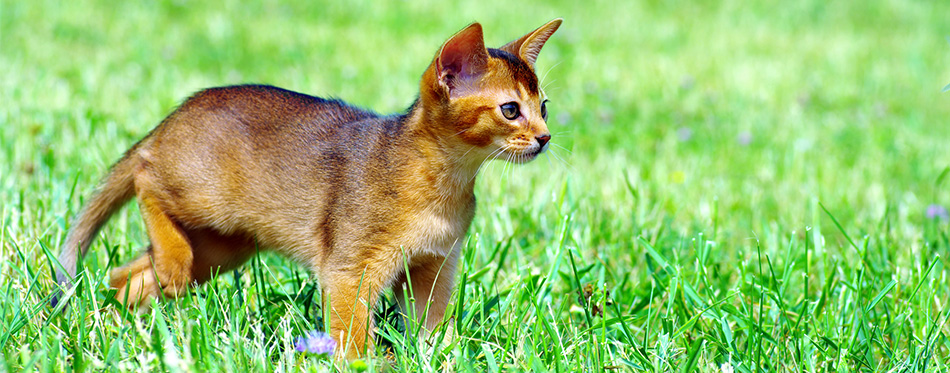
Temperament
Abyssinians are not your typical cats that show tolerant acceptance to their human companions. This is a breed that cherishes the companionship that humans provide. It is an affectionate cat breed; one of the best in the feline world. However, it is also very demanding. It wants its owner’s and his children’s attention. Some say the Aby can be clingy and needy.
These cats have a willful personality that goes well with their intelligence and curiosity. Abyssinians are fond of watching, playing, and interacting with people. Many pet owners may not recognize it but this breed can exert its control over its people. It can get you to do its bidding without you knowing or recognizing it.
Most cats avoid social gatherings, especially when there are children around. Not the Abyssinian, though. This breed relies on its natural intelligence and high energy levels to interact and play with kids. Its curious nature and people-watching abilities make it one of the best playmates for children. It doesn’t mind roughhousing. As long as the cat gets to play and use up its energy, everything should be fine.
Being intelligent and observant of its people, Abyssinians have a knack for mimicking human actions. It will watch you open the kitchen cabinet where you store your yummy biscuits. Sooner or later, the Aby will be opening the very same cabinet.
The Abyssinian cat has many fine qualities that make it one of the best breeds to bring home. It is intelligent, playful, affectionate, and biddable. The Aby is perfect for people who have other pets as well as families with kids.
Source:
- About the Abyssinian – CFA

